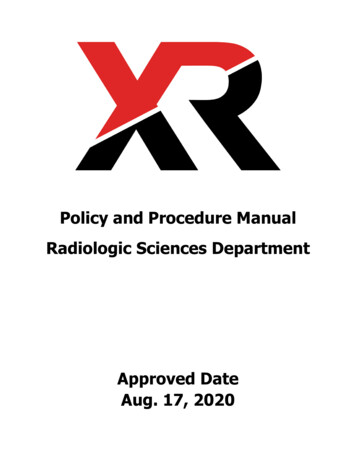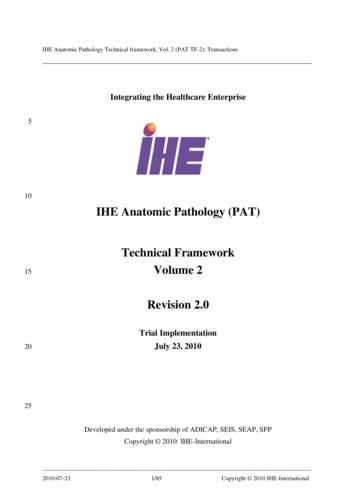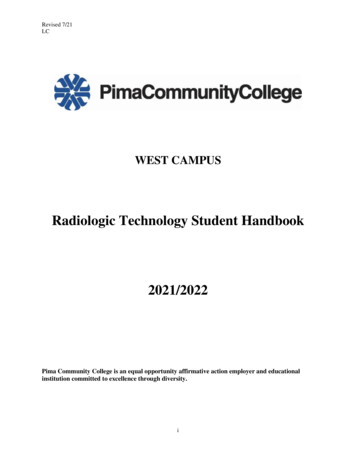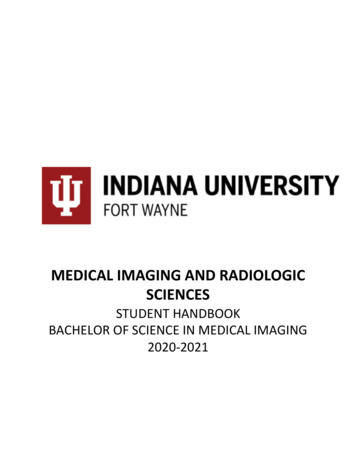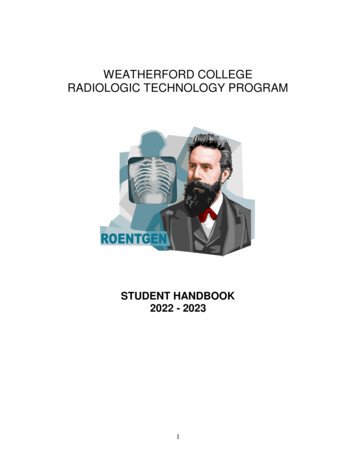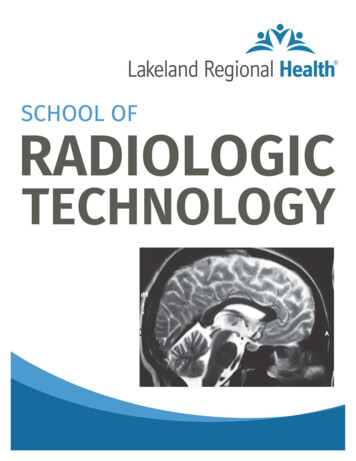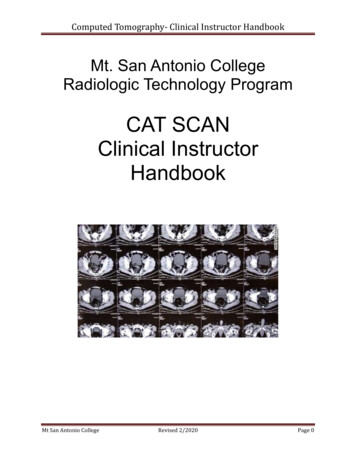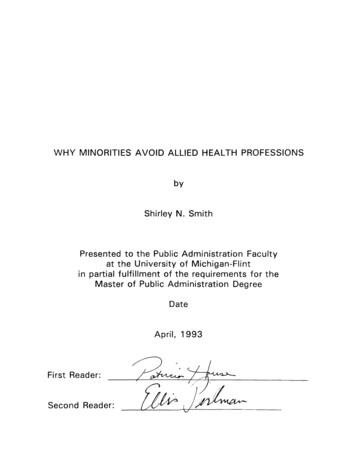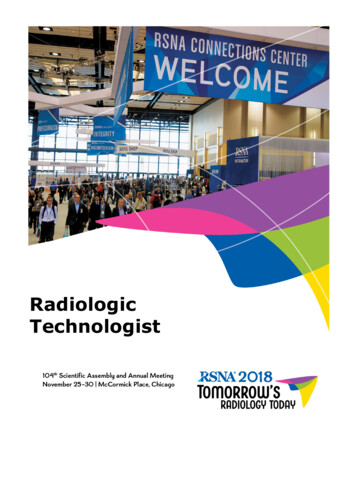
Transcription
RadiologicTechnologist
SPPH01AAPM/RSNA Physics Tutorial Session 1Saturday, Nov. 24 12:00PM - 2:00PM Room: E351BQGIMRNMPHAMA PRA Category 1 Credits : 2.00ARRT Category A Credits: 2.25FDADiscussions may include off-label uses.ParticipantsThaddeus A. Wilson, PhD, Madison, WI (Moderator) Nothing to DiscloseSub-EventsSPPH01APET/CT Introduction and Clinical ApplicationsParticipantsOsama R. Mawlawi, PhD, Houston, TX (Presenter) Research Grant, General Electric Company; Research Grant, Siemens AGFor information about this presentation, contact:omawlawi@mdanderson.orgLEARNING OBJECTIVES1) Describe the latest advances in hardware and software for PET/CT imaging. 2) Explain how these advances affect PET imagequality and quantification. 3) Describe novel PET/CT clinical applications using new radiopharmaceuticals. 4) Discuss futuredevelopments and clinical applications of PET/CT imaging.SPPH01BPET/MR Introduction and Clinical ApplicationsParticipantsRobert A. Pooley, PhD, Jacksonville, FL (Presenter) Nothing to DiscloseFor information about this presentation, contact:pooley.robert@mayo.eduLEARNING OBJECTIVES1) Describe reasons for combining PET and MR into a single scanner. 2) Explain how PET instrumentation can affect MR, and howMR instrumentation can affect PET. 3) Identify PETMR protocol acquisition strategies. 4) Describe clinical applications of PETMR.SPPH01CQuantitative SPECTParticipantsBenjamin M. Tsui, PhD, Baltimore, MD (Presenter) Researcher, Koninklijke Philips NV; License agreement, General Electric Company;For information about this presentation, contact:btsui1@jhmi.eduLEARNING OBJECTIVES1) Define quantitation and quantitative SPECT. 2) List and describe the image degrading factors of SPECT. 3) Describe methods tocompensate for the SPECT image degrading factors. 4) Assess quality and quantitative accuracy improvements of quantitativeSPECT images. 5) Apply quantitative SPECT to clinical practices.ABSTRACTRecent development and application of quantitative SPECT have provided significantly improved image quality and quantitativeaccuracy that aid in clinical diagnosis and treatment of diseases. In this educational course, we will define quantitation,quantitative SPECT and its goals. The image degrading factors of SPECT will be listed and described. Methods that compensates forthe image degradation factors will be presented and explained. Examples of improvements in image quality and quantitativeaccuracy in various clinical applications will be presented.Active Handout:Benjamin M. /RSNA-QuantitatveSPECT HandoutSPPH01C.pdf
SPPH02AAPM/RSNA Physics Tutorial Session 2Saturday, Nov. 24 2:15PM - 4:15PM Room: E351NMPHAMA PRA Category 1 Credits : 2.00ARRT Category A Credits: 2.25FDADiscussions may include off-label uses.ParticipantsThaddeus A. Wilson, PhD, Madison, WI (Moderator) Nothing to DiscloseSub-EventsSPPH02AThe Nuts and Bolts of Dosimetry in Nuclear Medicine and its ApplicationParticipantsMichael G. Stabin, PhD, Nashville, TN (Presenter) Software, Vanderbilt UniversityLEARNING OBJECTIVES1) Understand current models and methods used in radiation dosimetry for radiopharmaceuticals. 2) Understand methods for newdrug approval with the FDA. 3) Understand current experience with radiopharmaceuticals used in therapy: types of compounds,clinical experience, biological effects.SPPH02BTheranostics Introduction and ApplicationsParticipantsHossein Jadvar, MD, PhD, Pasadena, CA (Presenter) Nothing to DiscloseFor information about this presentation, contact:jadvar@med.usc.eduLEARNING OBJECTIVES1) Define theranostisc. 2) Review the history and current clinical applications of theranostics. 3) Describe potential outlook fortheranostics in the era of precision medicine.ABSTRACTAdvances in the understanding of cancer biology, developments in diagnostic technologies, and expansion of therapeutic optionshave all contributed to the concept of personalized cancer care. Theranostics is the systematic integration of targeted diagnosticsand therapeutics. The theranostic platform includes an imaging component that 'sees' the lesions followed by administration of thecompanion therapy agent that 'treats' the same lesions. This strategy leads to enhanced therapy efficacy, manageable adverseevents, improved patient outcome, and lower overall costs. In this lecture, I review the the concept, history, recent developments,current challenges, and outlook for radiotheranostics (use of radionuclides in theranostics) in the management of patients withcancer (Jadvar H et al. Radiotheranostics in Cancer Diagnosis and Management. Radiology 2018; 286:388-400).
MSAS21Evolving Imaging Methods for the Cancer Patient - Part 1 (Sponsored by the Associated Sciences Consortium)(Interactive Session)Monday, Nov. 26 8:30AM - 10:00AM Room: S105ABGIIRMROIUSAMA PRA Category 1 Credits : 1.50ARRT Category A Credit: 1.75FDADiscussions may include off-label uses.ParticipantsKristen Welch, RT, Milwaukee, WI (Moderator) Nothing to DiscloseWilliam A. Undie, PhD, RT, Houston, TX (Moderator) Nothing to DiscloseLEARNING OBJECTIVES1. Review evolving procedures within interventional radiology to treat cancer2. Review anatomy involved in evolving proceduresutilized to treat cancer patients3. Discuss historical methods utilized in the treatment of various cancers and their evolutionABSTRACTn/aSub-EventsMSAS21AAdvances in Liver Directed TherapyParticipantsSarah B. White, MD,MS, Philadelphia, PA (Presenter) Research support, Guerbet SA; Research support, Siemens AG; Consultant,Guerbet SA; Consultant, BSC; Consultant, Cook Group IncorporatedLEARNING OBJECTIVES1) Identify indications, contraindications, and complications of liver directed therapy. 2) Discuss the evolution of treatment optionsfor hepatocellular carcinoma. 3) Identify imaging involved in the care of patients with hepatocellular carcinoma.MSAS21BCombination Ablative TherapiesParticipantsAlexios Kelekis, MD, PhD, Athens, Greece (Presenter) Medical Advisory Board, BTG International Ltd; Medical Advisory Board, MeritMedical Systems, Inc; Research Grant, Mindray MedicalFor information about this presentation, contact:akelekis@med.uoa.grLEARNING OBJECTIVES1) Identify options for ablation for patients with cancer. 2) Discuss how ablative therapy combined with other therapies canimprove patient outcomes. 3) Review results of current studies in research utilizing combination ablative therapies.MSAS21CIntroduction to MR-Guided Focused UltrasoundParticipantsSharjeel Sabir, MD, Houston, TX (Presenter) Travel support, Johnson & Johnson;LEARNING OBJECTIVES1) Identify indications, contraindications, and complications for MR-Guided Focused Ultrasound. 2) Review procedural details ofperforming MR-Guided Focused Ultrasound. 3) Review current literature on MR-Guided Focused Ultrasound.
MSAS22Evolving Imaging Methods for the Cancer Patient - Part 2 (Sponsored by the Associated Sciences Consortium)(Interactive Session)Monday, Nov. 26 10:30AM - 12:00PM Room: S105ABNMOIAMA PRA Category 1 Credits : 1.50ARRT Category A Credit: 1.75ParticipantsNancy McDonald, MS, Chicago, IL (Moderator) Nothing to DiscloseWilliam A. Undie, PhD, RT, Houston, TX (Moderator) Nothing to DiscloseBernie McKay, BS, Chicago, IL (Presenter) Employee, Triad IsotopesKatie Tucker, BS, Chicago, IL (Presenter) Nothing to DiscloseLEARNING OBJECTIVES1) Improve basic knowledge and skills relevant to new imaging procedures and treatments for the cancer patient. 2) Assess thepotential applications to clinical practice and the treatments to these patients. 3) Assess the potential of new radiopharmaceuticalsto imaging and the treatment of the cancer patient. 4) How Nuclear Medicine is integrated with other modalities in the treatment ofthe cancer patient.
MSAS23Global Initiatives and Relief Efforts (Sponsored by the Associated Sciences Consortium) (Interactive Session)Monday, Nov. 26 1:30PM - 3:00PM Room: S105ABOTAMA PRA Category 1 Credits : 1.50ARRT Category A Credit: 1.75ParticipantsCatherine Gunn, MBA,RT, Halifax, NS (Moderator) Nothing to DiscloseSub-EventsMSAS23AA Multidisciplinary Approach to Global Radiology Outreach: RAD-AID's ExperienceParticipantsKaryn A. Ledbetter, MD, Detroit, MI (Presenter) Nothing to DiscloseFor information about this presentation, contact:karynl@rad.hfh.eduLEARNING OBJECTIVES1) Describe the current state of radiology resources in the developing world. 2) Understand the history and mission of RAD-AID. 3)Discuss what makes RAD-AID a unique organization in the area of global radiology outreach. 4) Appreciate special considerationsthat must be made when providing imaging in underserved areas. 5) Assess future volunteer opportunities with a more thoroughunderstanding of the complexity involved.MSAS23BHealthcare Aid in Africa: A Volunteer's Experience with Mercy ShipsParticipantsWilliam Creene, RT, Halifax, NS (Presenter) Nothing to DiscloseFor information about this presentation, contact:wcreene@gmail.comLEARNING OBJECTIVES1) Describe the medical and surgical need in developing nations. 2) Examine numerous conditions endemic to developing nationswhich require surgical intervention. 3) Describe the unique challenges of healthcare delivery and access in developing nations. 4)Assess the role of non-governmental organizations such as Mercy Ships in relieving the medical and surgical needs in developingnations.ABSTRACTThis presentation will be a synopsis of the speaker's experiences volunteering as a radiological technologist in West Africa aboardthe world's largest non-governmental hospital ship, the MV Africa Mercy. The ship is operated by Mercy Ships, an NGO whichprovides free surgical care to people of developing nations. Topics will include orthopedics, maxillofacial, general surgery, andwomen's health. Experiences and challenges related to healthcare delivery in the developing world will be discussed. A diverse rangeof CT and X-ray case studies with pathology unique to the developing world will be presented.
SPPH21Basic Physics Lecture for the RT: Dual Energy CT Applications in Radiation TherapyMonday, Nov. 26 1:30PM - 2:45PM Room: S402ABCTPHROAMA PRA Category 1 Credits : 1.25ARRT Category A Credits: 1.50ParticipantsScott J. Emerson, MS, Royal Oak, MI (Moderator) Nothing to DiscloseJessica Miller, PhD, Madison, WI (Presenter) Research Grant, Siemens AGFor information about this presentation, contact:scott.emerson@beaumont.orgLEARNING OBJECTIVES1) Explain basic dual-energy CT principles. 2) Compare current dual-energy CT techniques and associated limitations. 3) Identifydual-energy CT applications in radiation therapy.ABSTRACTNearly all patients treated with radiation therapy receive a computed tomography (CT) simulation scan for treatment planningpurposes. Dual-energy CT (DECT) allows for the reconstruction of supplementary information during the CT simulation process, suchas relative electron density and effective atomic number information, virtual monoenergetic images, and the differentiation ofmaterials. The additional information gained through DECT has potential to aid in several aspects of the radiation therapy process.This course will outline the basic principles of DECT and compare different vendor solutions for acquisition of DECT images. DECTapplications for radiation therapy will be discussed, including improving dose calculation accuracy, improving tumor and healthytissue delineation, characterizing treatment response, and identifying and sparing functional healthy tissue.
SPPH22Physics Symposium: Highlights of Medical Physics Leadership Academy (MPLA) Summer SchoolMonday, Nov. 26 1:30PM - 5:45PM Room: S503ABLMPHARRT Category A Credit: 0AMA PRA Category 1 Credits : 4.25ParticipantsJennifer Lynn Johnson, PHD, Houston, TX (Presenter) Nothing to DiscloseDaniel Pavord, MS, Poughkeepsie, NY (Presenter) Nothing to DiscloseRobert J. Pizzutiello JR, MS, Victor, NY (Presenter) Nothing to DiscloseMichael Howard, PHD, Chattanooga, TN (Presenter) Nothing to DiscloseFor information about this presentation, contact:ms jl johnson@yahoo.comLEARNING OBJECTIVESUnderstand the need to manage others' perceptions of medical physics. Develop awareness, knowledge and skills to create andmaintain a positive influence on others to achieve desired results. Analyze the integration of leadership, management and medicalphysics in day-to-day practice.ABSTRACTMedical physicists are respected for their technical expertise and contributions of physics principles and applications in biology andmedicine. In all work environments, however, medical physicists' technical and functional skills are not enough, especially as theyadvance in their career. No matter what career level, leadership and interpersonal skills are necessary. The 2016 AAPM SummerSchool provided a focused and hands-on environment for leadership and management skill development interwoven into the contextof medical physics. Session attendees will learn a working definition of leadership and the AAPM Medical Physics LeadershipAcademy (MPLA) program. Session attendees will also analyze operation and human resources scenarios by way of using personaland interpersonal knowledge and ault.aspActive Handout:Jennifer Lynn 094/2018 RSNA MPLA slides comb updated SPPH22.pdf
MSAS24Commitment to Safety: Providing Effective & Efficient Imaging Services (Sponsored by the AssociatedSciences Consortium) (Interactive Session)Monday, Nov. 26 3:30PM - 5:00PM Room: S105ABSQAMA PRA Category 1 Credits : 1.50ARRT Category A Credit: 1.75ParticipantsCraig St George, ARRT,RT, Albuquerque, NM (Moderator) Nothing to DiscloseJody Erickson, RT, BS, Jacksonville, FL (Presenter) Nothing to DiscloseAndre Brown, ARRT,MA, Jacksonville, FL (Presenter) Nothing to DiscloseAndrew Bowman, MD, PhD, Jacksonville, FL (Presenter) Nothing to DiscloseAdam Rubin, ARRT, RT, Jacksonville, FL (Presenter) Nothing to DiscloseFor information about this presentation, contact:bowman.andrew@mayo.eduLEARNING OBJECTIVES1) Understand the concept behind the Commitment to Safety process and how it was developed. 2) Identify how Commitment toSafety could be used to improve the work environment. 3) Define goals that could be accomplished through the Commitment toSafety process. 4) Understand how to begin Commitment to Safety initiative. 5) Know how to use results of a Commitment toSafety project to improve a work unit.
MSAS31Radiology Safety: Effective Strategies in Patient Care (Sponsored by the Associated Sciences Consortium)(Interactive Session)Tuesday, Nov. 27 8:30AM - 10:00AM Room: S105ABMRSQAMA PRA Category 1 Credits : 1.50ARRT Category A Credit: 1.75ParticipantsKendra Huber, RT, BS, Castle Rock, CO (Moderator) Nothing to DiscloseJoAnn Balderos-Mason, PhD,RT, Chicago, IL (Moderator) Nothing to DiscloseSub-EventsMSAS31ARadiation Safety and Protection in Diagnostic ImagingParticipantsSteffen Sammet, MD,PhD, Chicago, IL (Presenter) Research Grant, Koninklijke Philips NVFor information about this presentation, contact:ssammet@uchicago.eduLEARNING OBJECTIVES1) Radiation Units and Measurements. 2) Biological Effects of Ionizing Radiation. 3) Radiation Exposures in Diagnostic Radiology. 4)Principles of Radiation Protection and Radiation Safety.ABSTRACTSince the discovery of x-rays in 1895 by the German physicist Wilhelm Conrad Röntgen and the first reports of radiation injuries in1896, radiation safety and protection of patients have been fundamental responsibilities in diagnostic imaging. The fastadvancements in equipment that uses x-rays to form diagnostic images require radiation protection, dose monitoring and radiationsafety strategies. This course will present and review the most current radiation safety and protection requirements in DiagnosticRadiology.MSAS31BMRI Contrast and Protocol OptimizationParticipantsMatt Rederer, BS, RT, Elgin, IL (Presenter) CEO, RITE Advantage, LLCMSAS31CMRI Safety Made Complicated and DangerousParticipantsMark A. Smith, MS, ARRT, Columbus, OH (Presenter) Nothing to DiscloseFor information about this presentation, contact:mark.smith@nationwidechildrens.orgLEARNING OBJECTIVES1) Identify MR safety concerns. 2) Recognize previous mistakes. 3) Identify proper MR safety policies and procedures. 4) IdentifyMR safety update on implants/devices. 5) Recognize strategies for successful MR safety practices.ABSTRACTMR technology and it's clinical applications have expanded rapidly in recent years. As a result, the safety of patients, family andstaff is a primary concern, with MR safety awareness and training has become increasingly important. This presentation will reviewthe essentials of MR safety that all personnell present in the MR environment should be familiar with.Active Handout:Mark Aaron 4/RSNA 2018 MRI Safety handoutMSAS31C.pdf
MSAS32Understanding the Critical Relationships of Quality, Experience, and Performance for Effective ImagingServices (Sponsored by the Associated Sciences Consortium) (Interactive Session)Tuesday, Nov. 27 10:30AM - 12:00PM Room: S105ABINSQAMA PRA Category 1 Credits : 1.50ARRT Category A Credit: 1.75ParticipantsMorris A. Stein, BArch, Phoenix, AZ (Moderator) Nothing to DiscloseWilliam A. Undie, PhD, RT, Houston, TX (Moderator) Nothing to DiscloseFor information about this presentation, contact:mstein@hksinc.comSub-EventsMSAS32APlanning and Physical Implications through Data, Modeling, and VisionParticipantsCarlos L. Amato, Los Angeles, CA (Presenter) Nothing to DiscloseFor information about this presentation, contact:camato@cannondesign.comLEARNING OBJECTIVES1) Understand the current status of Appropriate Use Criteria (AUC) consultation requirements. 2) Review workflow considerationsfor AUC consultations requirements for all process flow scenarios including employed and non-employed referring providers. 3)Understand how recent technological advances and discoveries will impact imaging space planning, and how to incorporate FDIguidelines in imaging department designs. 4) Understand how to adjust facility design(s) to align with the latest consumerexpectations and trends affecting the patient experience. 5) Recognize the pitfalls and accomplishments of Clinical Decision SupportMechanism (CDSM) early adoption. 6) Explain the common barriers of CDSM interoperability with hospital electronic health record(EHR), standardization of operational flow of information, and key performance indicators (KPI) development.MSAS32BThe Changing World of How Clinical Support Systems Impact Quality and Delivery of CareParticipantsMelody W. Mulaik, Powder Springs, GA (Presenter) Nothing to DiscloseFor information about this presentation, contact:melody.mulaik@codingstrategies.comLEARNING OBJECTIVES1) Understand the current status of Appropriate Use Criteria (AUC) consultation requirements. 2) Review workflow considerationsfor AUC consultations requirements for all process flow scenarios including employed and non-employed referring providers. 3)Understand how recent technological advances and discoveries will impact imaging space planning, and how to incorporate FDIguidelines in imaging department designs. 4) Understand how to adjust facility design(s) to align with the latest consumerexpectations and trends affecting the patient experience. 5) Recognize the pitfalls and accomplishments of Clinical Decision SupportMechanism (CDSM) early adoption. 6) Explain the common barriers of CDSM interoperability with hospital electronic health record(EHR), standardization of operational flow of information, and key performance indicators (KPI) development.MSAS32CLessons Learned in Adopting Clinical Decision Support SystemsParticipantsErnesto A. Cerdena, PhD, Atlantic City, NJ (Presenter) Nothing to DiscloseFor information about this presentation, contact:ernesto.cerdena@atlanticare.orgLEARNING OBJECTIVES1) Recognize the pitfalls and accomplishments of Clinical Decision Support Mechanism (CDSM) early adoption. 2) Identify and explainthe common barriers of CDSM interoperability with the hospital electronic health record (EHR) and standardization of flow ofinformation. 3) Develop an understanding of the key performance indicators available within the CDSM system.
MSAS33Building the Management 'A Team' (Sponsored by the Associated Sciences Consortium) (Interactive Session)Tuesday, Nov. 27 1:30PM - 3:00PM Room: S105ABLMAMA PRA Category 1 Credits : 1.50ARRT Category A Credit: 1.75ParticipantsPatricia Kroken, Albuquerque, NM (Moderator) Nothing to DiscloseSub-EventsMSAS33AManaging at the Tip of the Spear: Radiology Practices Face Turbulent TimesParticipantsRobert Still, Fairfax, VA (Presenter) Nothing to DiscloseFor information about this presentation, contact:bob.still@rbma.orgLEARNING OBJECTIVES1) Identify the essential communication skills physician practice managers and physician leaders need to possess. 2) Examineseveral physician practice environments that foster a synergistic team: Radiologist/Practice Administrator/Hospital administrator. 3)Detect weaknesses in their radiology practices that may hinder positive management focus. 4) Develop new pathways to positivemanagement initiatives within a rapidly changing radiology business model.ABSTRACTThis session will provide an overview and specific strategies to create a synergistic leadership team between a radiologist, aradiology practice administrator or CEO and a hospital radiology department administrator. Participants will be able to return to theirpractice leadership positions with practical and time tested leadership strategies for success.MSAS33BPartnering with Your Administrator to Lead Enterprise Initiatives: How to Be at the Table and Not onthe MenuParticipantsChris Tomlinson, Philadelphia, PA (Presenter) Nothing to DiscloseFor information about this presentation, G OBJECTIVES1) Identify opportunities for radiology to lead initiatives across the healthcare enterprise. 2) Position radiology as an enabler for riskbased payer contracts (appropriate use, utilization management). 3) Enable radiology to be at the table for enterprise decisionmaking by enabling areas outside of radiology to be successful. 4) Provide examples of areas to show enterprise leadership.
MSAS34The Importance of Radiographer Led Research: Growing the Evidence Base (Sponsored by the AssociatedSciences Consortium) (Interactive Session)Tuesday, Nov. 27 3:30PM - 5:00PM Room: S105ABRSAMA PRA Category 1 Credits : 1.50ARRT Category A Credit: 1.75ParticipantsCharlotte Beardmore, MBA, London, United Kingdom (Moderator) Nothing to DiscloseDimitris Katsifarakis, MSc, London, United Kingdom (Moderator) Nothing to DiscloseFor information about this presentation, contact:charlotte@sor.orgSub-EventsMSAS34AThe Impact of Radiographer Led Research: A Case Study from the UKParticipantsRichard Evans, London, United Kingdom (Presenter) Nothing to DiscloseLEARNING OBJECTIVES1) To understand the value of 'radiographer led' research within clinical imaging services. 2) To understand the steps required indeveloping a local research strategy. 3) To understand how to examine opportunities and barriers within your clinical environmentto help support effective research.ABSTRACTAs Health Care Professionals, radiographers and technologists are encouraged to put the patient at the centre of everything we do.In the UK, the Society and College of Radiographers (SCoR) state that this level of care should be based on up to date evidencethat is of a high quality, using research to meet the needs of the patient. This drive to encourage research is also mirrored by theAllied Health Professions Federation (AHPF), who have published a strategy with one of its key goals focussed on the impact ofresearch methods and evaluation on population outcome. Historically, research undertaken by radiographers in the UK has beenminimal. In 2015, a review of contributors to the journal for The European Federation of Radiographer Societies found that of 239contributing author affiliations, only 22 were represented by UK hospitals. Factors restricting engagement with research could bedue to a lack of research experience and confidence among radiography practitioners and technologists, and a culture whereresearch is not seen as a priority. In busy departments; time, lack of role models, difficulties in back filling roles and resistance tochange, along with ever increasing imaging demands, have led to further barriers in undertaking research. The question remains asto how we bridge the gap between embedding research in all levels of radiographic practice and current clinical research activity?The purpose of this presentation will be to focus on our research journey within a UK radiography department. We will share howwe overcame barriers through collaboration and establishing a local research strategy to facilitate our research ideas. As a result,we will demonstrate how this led to achieving successes regarding the positive impact of research, both on our patients and staff.MSAS34BShifting the Paradigm of Medical Imaging: How Imaging Can Drive Innovations in Patient Care (ACanadian Experience)ParticipantsPaul Cornacchione, BSC, Toronto, ON (Presenter) Nothing to DiscloseLEARNING OBJECTIVES1) Identify the benefits of an integrated project management team within medical imaging. 2) Share the impact that a medicalimaging department and extended practice roles can have in driving patient care. 3) Highlight the use of data in developing andmonitoring initiative outcomes.
MSRT41ASRT@RSNA 2018: Ultrasound versus MRI for Imaging of the Female PelvisW ednesday, Nov. 28 8:00AM - 9:00AM Room: N230BGUMRUSAMA PRA Category 1 Credit : 1.00ARRT Category A Credit: 1.00ParticipantsDeborah Levine, MD, Boston, MA (Presenter) Editor with royalties, Taylor & Francis Group; Editor with royalties, Reed Elsevier;For information about this presentation, contact:dlevine@bidmc.harvard.eduLEARNING OBJECTIVES1) Understand the various adnexal masses that can be confused with neoplasms, and when MR might be useful in differentiatingvarious types of adnexal masses. 2) Recognize features of endometriosis and when MR can add additional information that mightalter patient care. 3) Understand the role of MR in triage of patients potentially under uterine artery embolization for fibroids.
MSRT42ASRT@RSNA 2018: Tips and Tricks - Radiation Dose Aspects in Oncologic CT ImagingW ednesday, Nov. 28 9:20AM - 10:20AM Room: N230BCTOISQAMA PRA Category 1 Credit : 1.00ARRT Category A Credit: 1.00ParticipantsDianna D. Cody, PhD, Houston, TX (Presenter) In-kind support, General Electric Company; Reviewer, ACR CT accreditation program;Researcher, Gammex, IncLEARNING OBJECTIVES1) Better understand 'routine' CT imaging performed in a cancer center. 2) How this particular cancer center approaches abdominalCT imaging without IV contrast. 3) Appreciate scan options for CT imaging of very large patients. 4) Comprehend implementation ofdual-energy CT for oncology.ABSTRACTThe management of CT radiation exposure for cancer patients presents a difficult dilemma. We know that each exposure has asmall probability of inducing radiation damage, but we must weigh that knowledge against the fact that the patient already hascancer, and may have a reduced life expectancy as a result. Patient management decisions often hinge on a detailed appreciationof the patient's present condition, and CT can provide critical information in this respect. In our practice, the concern for shortterm survival typically supersedes the long term and complex risk associated with CT dose. The concept of what is 'routine' CTimaging at our oncology center will be explored, with a focus on our most frequently performed exams and typical scan parameters.CT dose metrics will be reviewed and compared to naitonal benchmarks for several routine CT exams. Our approach to abdominal CTprotocols designed for use wihtout IV contrast will be covered, as well as several options for imaging our very large cancerpatients. How we have implemented dual-energy CT, and its benefits, will also be illustrated.
MSRT43ASRT@RSNA 2018: Radiologist Assistants-Who We Are and How We Can HelpW ednesday, Nov. 28 10:40AM - 11:40AM Room: N230BOTAMA PRA Category 1 Credit : 1.00ARRT Category A Credit: 1.00ParticipantsJoann T. Yokley, RRA,BS, Greensboro, NC (Presenter) Nothing to DiscloseVicki Sanders, Wichita Falls, TX (Presenter) Nothing to DiscloseTravis N. Prowant, MS, RT, Richmond, VA (Presenter) Nothing to DiscloseWesley Shay, New York, NY (Presenter) Nothing to DisclosePaige Mebus, New York, NY (Presenter) Nothing to DiscloseFor information about this presentation, contact:mebusp@mskcc.orgLEARNING OBJECTIVES1) Describe RA education and clinical training. 2) Identify issues with legislation, reimbursement, and supervision. 3) Identifybeneficial use of RA in a variety of fluoroscopy exams, interventional procedures, interventional radiology clinic, and breast imagingcenters. 4) Explain how the RA is used to enhance overall patient care, provide continuity of care, and maximize efficiency. 5)Show the satisfaction current radiologists have when employing radiologist assistants.ABSTRACTAs radiologic technologists with advanced training in radiological procedures, image assessment, patient management andassessment, Radiologist Assistants (RAs) are physician extenders specifically designed for the medical imaging environment. RAspractice under the supervision of the radiologist: to perform non-invasive and invasive medical imaging procedures; evaluate,manage, and educate patients; communicate radiologist findings with other members of the healthcare team; and act as patientnavigators for the imaging department. Due to RAs' specialized education and training, they maximize
Assess the role of non-governmental organizations such as Mercy Ships in relieving the medical and surgical needs in developing nations. ABSTRACT This presentation will be a synopsis of the speaker's experiences volunteering as a radiological technologist in West Africa aboard the world's largest non-governmental hospital ship, the MV Africa Mercy.
